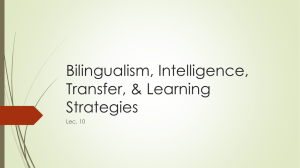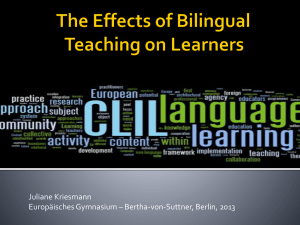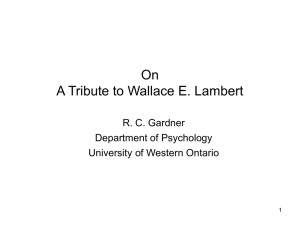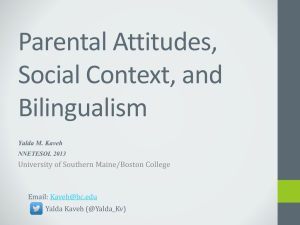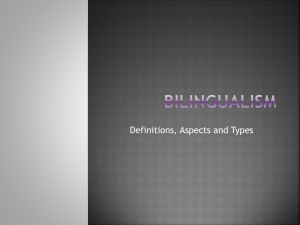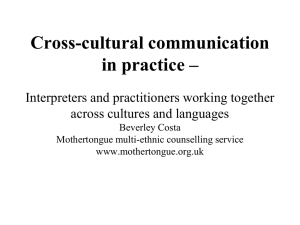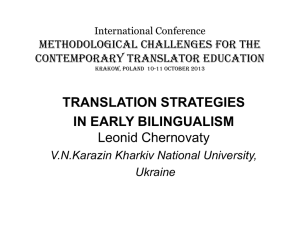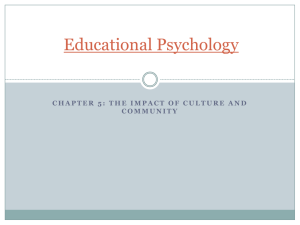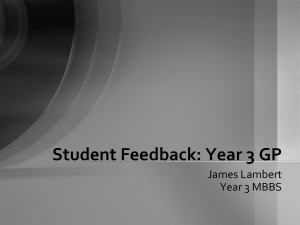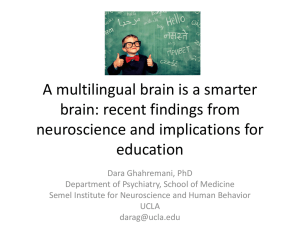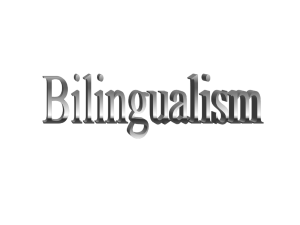Peal & Lambert's Bilingualism Legacy: Canadian Research
advertisement
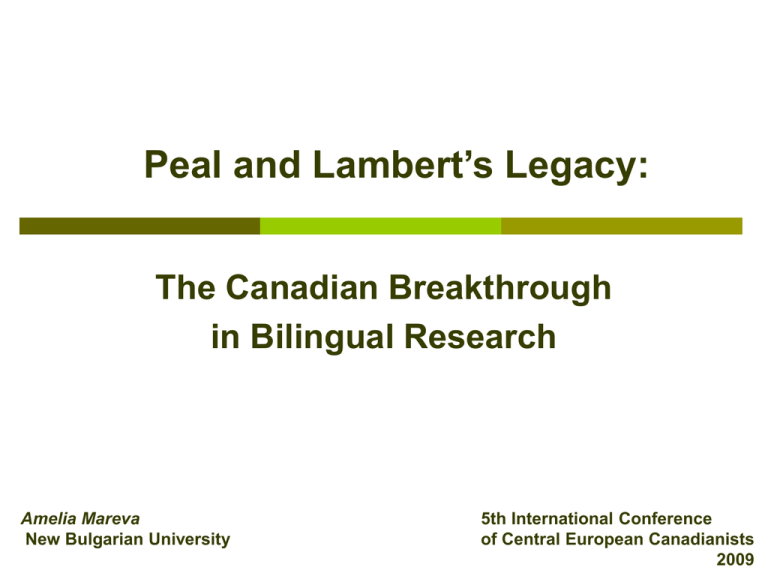
Peal and Lambert’s Legacy: The Canadian Breakthrough in Bilingual Research Amelia Mareva New Bulgarian University 5th International Conference of Central European Canadianists 2009 Contemporary context Bilingualism/multilingualism a major fact of life in the world today (Bhatia & Ritchie 2004) far from being exceptional is a problem which affects the majority of the world’s population (Mackey 1967) exists in nearly all countries of the world (Grosjean 1982) the majority of the world’s population is bilingual (DeBot 1992) an increasing number of children grow with “bilingualism as a first language” (Hakuta 1986) two-thirds of the world’s children grow in a bilingual environment (Crystal 1997) there is a real sense in which a monolingual person, with a monolingual temperament, is disadvantaged or deprived (Crystal 2000) the doom of monolingualism (Graddol 2006) monolingualism is an aberration, an affliction of the powerful (Edwards 2004) Theoretical context Bilingual research Has grown dramatically worldwide, especially in Canada, Belgium, South Africa, the USA, etc. The concept one nation – one language lost its relevance in linguistics: the point of reference is no longer the ‘ideal monolingual speaker/listener’ (Romaine 1989) Bilingualism defined: a complex concept with ‘open-ended semantics’ (Beardsmore 1986); Bloomfield 1933, Haugen 1953, Weinreich 1953 The debate on the positive and negative effects of bilingualism Early studies: ‘retarded’, ‘confused’, ‘feeble-minded’, ‘handicapped’ in their mental growth (Saer 1924, Goodenough 1926, Thomson 1952) If it were possible for a child to live in two languages, at once equally well, so much the worse. His intellectual and spiritual growth would not thereby be doubled, but halved (Laurie 1893: 18) Peal and Lambert’s watershed paper: favourable cognitive and socio-cultural consequences of bilingualism Modern perspectives: Bilingualism is viewed as a factor of cultural enrichment, a valuable intellectual and societal asset Elizabeth Peal and Wallace Lambert’s The Relation of Bilingualism to Intelligence (1962) A bilingual child is […] a youngster whose wider experiences in two cultures have given him advantages which a monolingual does not enjoy. Intellectually his experience with two language systems seems to have left him with a mental flexibility, a superiority in concept formation, a more diversified set of mental abilities […] There is no question about the fact that he is superior intellectually. […] In contrast, a monolingual appears to have a more unitary structure of intelligence which he must use for all types of intellectual tasks (Peal and Lambert 1962:20) The Canadian backdrop The twentieth century belongs to Canada (Wilfrid Laurier, PM, 1904) Socio-political context: redefining the role of French Canadians The Quiet Revolution (1960–1966): rejection of traditional values “les trois dominantes de la pensée canadienne-française: l’agriculturisme, le messianisme et l’anti-étatisme” (Michel Brunet) the Official Languages Act (1969) Academic climate The era of the “cognitive sixties” Study of bilingualism has been a respectable and theoretically profitable enterprise in Canadian psychological circles. [Canadian researchers] are confronted with bilingualism even in their own homes, as their children attempt to struggle with bilingualism (Hakuta 1988: 304) W. Lambert – ‘father of research on bilingualism’ The experiment Subjects: number, age, gender, class, proficiency Two groups of 110 ten-year old fourth-graders from six middle-class French schools in Montreal with a gender ration of six boys to four girls: ‘balanced’ French-English bilinguals and French monolinguals Testing instruments: verbal and non-verbal IQ tests language tasks and self-rating Results: Bilinguals scored higher than monolinguals on 15 out of 18 measures; no significant difference on the remaining three measures. Methodological breakthrough Peal and Lambert “rectified many of the methodological weaknesses” of the previous studies (Baker and Sienkewicz 2000: 69) More rigorous criteria for sampling and control of the variables involved aiming to “to match the groups on as many features known or suspected to correlate with intelligence as possible” (Peal & Lambert 1962): socioeconomic status of the comparison groups: educational background (the same French school system), similar socioeconomic background (relatively affluent middle-class Francophones, a linguistically rich environment) linguistic proficiency: “true, balanced bilinguals” vs. “pseudobilinguals” battery of testing instruments language proficiency: The Word association test, the Word detection test, Peabody vocabulary tests intelligence: standardized in the native language of the subject – LavoieLaurendau test, Raven Progressive Matrices Test, Thurstone Primary Mental Abilities Test and subject’s school grades attitude: questionnaires, self-ratings Theoretical contribution (1) Bilingualism and intelligence more ‘diversified structure of intelligence’: greater cognitive flexibility, creativity and divergent thought greater role of language(s) in structuring intelligence better at reorganizing visual patterns and better equipped to solve mental problems greater metasemiotic and metalinguistic awareness Research after 1962 has tended to move away from the “monistic” notion of IQ to the “pluralistic” notion of a multi-component view of intelligence and cognition’ (Baker 1988: 20) Theoretical contribution (2) Code switching: the alternation two languages within a single discourse. Bilinguals typically acquire experience in switching from one language to another, possibly trying to solve a problem while thinking in one language, and then when blocked, switching to the other. This habit, if it were developed, could help them in their performance on tests requiring symbolic reorganization since they demand a readiness to drop one hypothesis or concept and try another. (Peal and Lambert 1962:14) flexibility in tasks requiring conceptual reorganization (thinking about things in a new way) increased capacity for communication (signaling membership in a group, maintaining group cohesiveness, but also a sign of language interference) The impact (1) Research 1970s Lambert 1972, 1976: first neurophysiological studies; social psychology of language Liedtke and Nielson 1968, Bain 1974: confirm the findings in other parts of Canada Ianco-Worrall 1972: the relationship between object-naming ability and bilingualism Ben-Zeev 1977: bilingual’s superiority in conceptualizing linguistic rules Cummins: 1976, 1978: ‘threshold’ level of competence; the interdependence hypothesis Duncan and De Avila 1979: positive correlation between linguistic proficiency and bilingualism 1980s Diaz 1983, Gardner 1983 Cummins 1984, Mclaughlin 1984, Bain and Yu 1989 1989 The McGill Conference in Honour of Wallace E. Lambert Present day: Bialystok 2001, Baker 2001, Cummins 2001 The impact (2) Education Mid-1960s - Lambert and Tucker pioneered the development of Canada’s first second language immersion programme – the “Canadian model of bilingual education” (innovative programme in which the French language was used as a medium of instruction for elementary school students whose home language was English) Students in bilingual immersion programs have scored as well as their nonbilingual peers in tests of their common language, but much higher in the second (minority or foreign) language. Students in bilingual programs have greater metalinguistic awareness than monolingual students. For example, young children are more aware that the name of something is simply a convention of language – it is not an inherent property of the thing itself. They understand that a language is an arbitrary system; that there is no “right” language against which other languages can be judged. This is an essential awareness in a multilingual and multicultural world. List of selected references Baker, Colin, (2001). Foundations of Bilingual Education and Bilingualism. Multilingual Matters. Baker, Colin and Anne Sienkewicz, (2000). The Care and Education of Young Bilinguals. Multilingual Matters. Bhatia, Tej K. and Ritchie, William C, (2004). Handbook of Bilingualism. Oxford: Blackwell Publishing. Bialystok, Ellen, ( 2001) Bilingualism in Development: Language, Literacy and Cognition, CUP. Crystal, David, (2000) Language Death. CUP. Cummins, Jim, (1976). The Influence of Bilingualism on Cognitive Growth: A Synthesis of Research Findings and Explanatory Hypothesis. Working Papers on Bilingualism, 9, 1-43 Graddol, David, (2006). English Next, British Council, UK, http://www.britishcouncil.org/files/documents/learning-research-english-next.pdf Hakuta, Kenji, (1986) The Mirror of Language: The Debate on Bilingualism. New York: Basic Books. Hakuta, Kenji, Bernardo M. Ferdman and Rafael M. Diaz, (1987). Bilingualism and cognitive development: Three perspectives. In S. Rosenberg (Ed.), Advances in applied psycholinguistics, vol. II: Reading, writing and language learning, 284-319. CUP. Ianco-Worrall Anita D., (1972). Bilingualism and cognitive development. Child Development, 43, 1390-1400 Laurie, S. S., (1893). Lectures on Language and Linguistic Method in the School. University of Edinburgh. http://www.archive.org/texts/flipbook/flippy.php?id=languagelinguist00laur Peal, Elizabeth and Lambert, Wallace, (1962). The Relation of Bilingualism to Intelligence, Psychological Monographs, 76, 1–23. Reynolds, Allan, (1991). Bilingualism, Multuculturalism and Second Language Learning: The McGill Conference in Honour of Wallace E. Lambert (ed) Allan G. Reynolds, Lawrence Erlbaum Associates. Romaine, Suzanne, (1995). Bilingualism, Blackwell Publishing. Weinreich, Uriel, (1953). Languages in Contact: Findings and Problems. New York : Linguistic Circle
